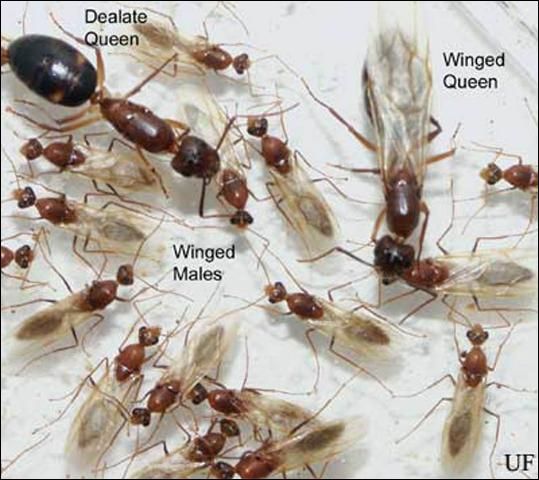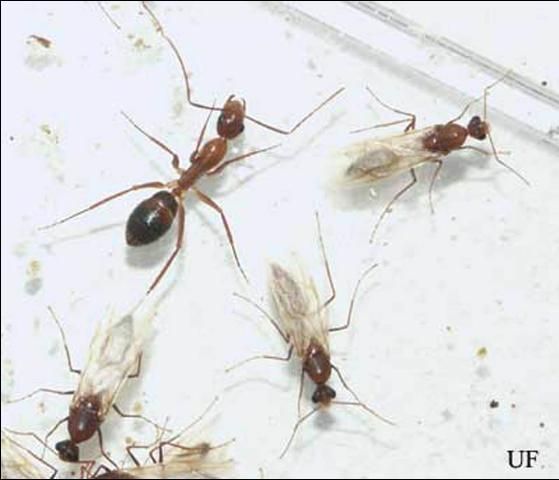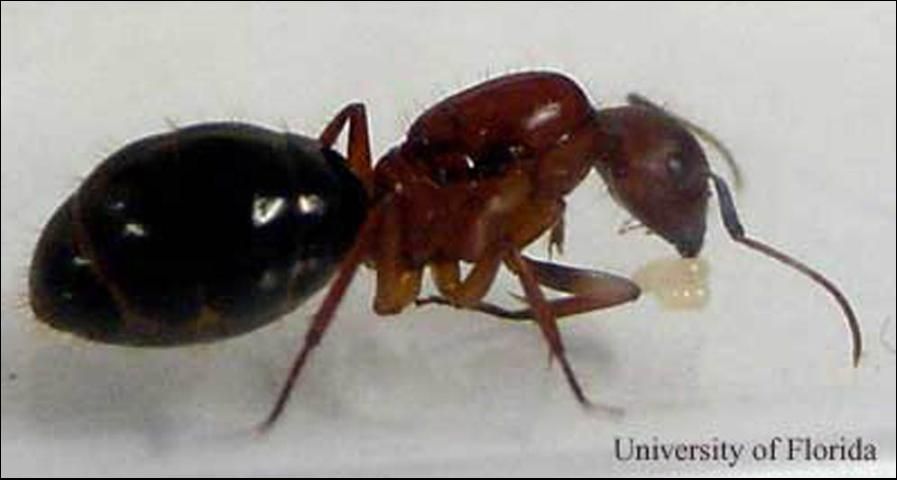The Featured Creatures collection provides in-depth profiles of insects, nematodes, arachnids and other organisms relevant to Florida. These profiles are intended for the use of interested laypersons with some knowledge of biology as well as academic audiences.
Introduction
The Florida carpenter ant complex is comprised of several species, two of which are common around structures: Camponotus floridanus (Buckley) and Camponotus tortuganus (Emery). These bicolored arboreal ants are among the largest ants found in Florida, making them apparent as they forage or fly indoors and out.

Credit: Rudolf H. Scheffrahn, UF/IFAS
In a survey of common urban pest ant species covering four metropolitan areas of Florida (Daytona-Orlando, Tampa Bay area, Sarasota-Ft. Myers, and the greater Miami area), Klotz et al. 1995 found that infestations of Florida carpenter ants accounted for approximately 20% of all ant complaints by homeowners. Klotz et al. (1995) found only a few instances where other ants, including imported fire ant (Solenopsis invicta Buren), crazy ant (Paratrechina longicornis (Latreille), ghost ant (Tapinoma melanocephalum (Fabr.), and pharaoh ant (Monomorium pharaonis (L.)) were more frequently encountered in buildings than carpenter ants.
During the flight season, carpenter ants can often be found in alarming numbers. Sometimes homeowners are concerned about damage to the structural integrity of their homes, which they sometimes incorrectly learn is caused by Florida carpenter ants. However, unlike the wood-damaging black carpenter ant, Camponotus pennsylvanicus (DeGreer), found in Florida's panhandle and a few other western U.S. species, Florida carpenter ants seek either existing voids in which to nest or excavate only soft materials such as rotten or pithy wood and Styrofoam. Other concerns are that these ants sting (they do not) and bite (they do).
In recent years, a small and exotic daytime-foraging carpenter ant, Camponotus planatus Roger, has become common in many parts of central and southern Florida.

Credit: Rudolf H. Scheffrahn, UF/IFAS
Camponotus floridanus is found widely distributed throughout Florida and some neighboring states, while Camponotus tortuganus is limited to central and southern portions of Florida. The ratio of C. floridanus to Camponotus tortuganus is about 2:1 in south Florida. There are several other Camponotus species found in Florida; however, these are rare or usually not associated with buildings. These species include Camponotus caryae (Fitch), Camponotus castaneus (Latreille), Camponotus decipiens Emery, Camponotus discolor (Buckley), Camponotus impressus (Roger), Camponotus nearcticus Emery, Camponotus pylartes Wheeler, Camponotus sexguttatus (Fabr.), Camponotus snellingi Bolton, and C. socius Roger.
Description
The antennae of Florida carpenter ants are 12-segmented, with the terminal segment being slightly elongated and bullet-shaped, and without a club. There is a circular ring of hair at the end of the abdomen. The waist consists of one petiolar segment. The antennal scape is flattened basally and broad throughout. Workers vary in size, ranging from 5.5 to 11 mm (0.2 to 0.4 in) in length. Smaller workers are called minors while larger workers are called majors. Winged females (alates) are the largest caste reaching up to 20 mm (3/4 in) in length. There is no sting, but workers can bite and spray formic acid for defense. The thorax is evenly convex, a key characteristic of carpenter ants. The thorax and head are ash brown to rusty-orange and the gaster is black. Body hairs are abundant, long, and golden. Male reproductives are much smaller than queens with proportionally smaller heads and larger wings. Specific characters for Camponotus floridanus include legs and antennal scapes with numerous long, coarse brown to golden erect hairs, shorter than those on the body. For Camponotus tortuganus, specific characters include a major worker with head longer than broad; tibia of all legs and antennal scapes without erect hairs; and thinner than Camponotus floridanus and paler with less color contrast.

Credit: Rudolf H. Scheffrahn, UF/IFAS

Credit: Rudolf H. Scheffrahn, UF/IFAS

Credit: Rudolf H. Scheffrahn, UF/IFAS
Life Cycle
As with all members of the Order Hymenoptera, carpenter ants develop by complete metamorphosis, going through stages of the egg, larva, pupa, and adult worker or reproductive. Larvae are maggot-like, and pupae reside in silk cocoons and are often mistaken for eggs. Winged reproductives fly in the evening or night during the rainy season (May through November). Typically, a single queen, fertilized by a smaller short-lived male, will start a new colony, caring for her first brood of larvae until they develop into workers, which then begin to forage for food. Workers then care for the queen and ensuing brood. The colony will continue to grow and populations may reach several thousand workers. When the colony is two to five years old, depending on environmental conditions, new winged reproductives, or alates, will usually be sent out. Alates (winged reproductives) are observed from spring to fall, depending on the area and environmental conditions. Queenless satellite nests are often founded within 20 to 100 feet of a mature nest. Proximity of nests can lead to fighting among neighboring colonies.

Credit: John Warner, UF/IFAS

Credit: Rudolf H. Scheffrahn, UF/IFAS

Credit: Rudolf H. Scheffrahn, UF/IFAS
Pest Status
Carpenter ants are one of the most common indoor insect pests in Florida. Alarmed homeowners often see these ants foraging (especially at night) and either attempt to control the ants with spray insecticides or call their local pest control operator (PCO). PCOs report going to innumerable homes to speak with frantic homeowners who have failed to control foraging or flying carpenter ants. Many PCOs and seasoned entomologists have resigned to failure after not being able to treat hidden nesting sites, sometimes after years of trying! An experienced pest control operator, or a determined homeowner, can usually follow a trail of ants back to the ants' nesting site and treat it (see Management below).
Complaints are numerous during the spring swarm season, usually between April and June, when winged reproductives are often found in homes in such places as along window ledges and near sliding glass doors. It is common to mistake winged ants for winged termites. Differences between ants and termites are given below.

Credit: Rudolf H. Scheffrahn, UF/IFAS

Credit: Rudolf H. Scheffrahn, UF/IFAS
Foraging and Feeding
Florida carpenter ants tend to forage at night. The peak foraging hours are just before sunset until two hours after sunset, then again around dawn. Foraging proceeds in very loosely defined trails or by individual ants that seem to wander aimlessly. These ants have a fondness for sweets and can be found in campgrounds near soda machines and other areas where sweets are readily accessible. Similarly, they are fond of sweet floral nectars and honeydews produced by sucking insects, especially aphids, scales, and mealybugs. Trees and shrubs which are infested with these honeydew-producing insects or produce nectars will have ants wandering in all directions over leaf surfaces, up and down the stems and trunk. Carpenter ants will also seek out other insects, both living and dead, for food.
Carpenter ants foraging in homes can be in search of sweets or moisture, or even new nesting sites, especially in kitchens and bathrooms, or other rooms that have water leaks from plumbing or leaks around doors and windows. Otherwise, they might simply be trailing from an interior nest to an exterior food source.
Carpenter ants, like many other ants, will trail along wires or cables that may be attached to homes and serve frequently as access routes for them to enter attics and other above ground areas. Tall trees touching structures cause "bridges" which provide foraging access into buildings.
Nest Sites
Carpenter ants seem to prefer voids for nesting that have these characteristics:
- Close to moisture and food sources
- Safe from predators such as birds and lizards
- Safe from flooding, heat, and other environmental stresses
- Easily accessible (for them, but inaccessible for the PCO!)
They will hollow out wood softened by moisture and/or fungi to create nests. This wood can be in tree stumps or dead tree limbs, or in any part of a structure having damaged wood. They will not excavate nesting galleries in sound wood. Bits of debris, called frass, are often ejected from nesting sites. Frass consists of bits of excavated materials and pieces of dead insects, including carpenter ants.
Common exterior nesting sites include old drywood termite galleries and wooden objects that have had previous damage from other organisms including insects or fungi; rotting tree stumps and tree holes or crotches between limbs; under old leaf petioles in palms, especially in and around the inflorescence of coconut palms; under bark, in roots of trees, especially citrus trees; in old wooden fences, sheds, old wooden decks, bamboo poles (even thin or short pieces) or tree supports, debris of almost any kind, coconuts left on the ground, under mulch, inside logs or wooden borders in gardens, railroad ties, old shoes, in voids in ceramic or concrete decorations, walls or support pillars, in expansion joints either not filled in or filled with rubbery materials, under stones, in home exterior coverings, especially wood panels, and so on.
Common interior nesting sites include wall voids (especially walls that have moisture seepage), under attic insulation and usually near the eaves where they are very difficult to reach, under bathtubs, very common under windows and door frames which have moisture intrusion from rain or sprinklers, around skylights, in boxes or paper bags, in closets which are not often used, under appliances, especially dishwashers, in flat roofs (one of the most difficult problems due to lack of adequate access), behind wood panels, in wood furniture, between cracks in floors, under bathroom fixtures, and many other places! Carpenter ants are sometimes found in electrical boxes, such as fuse, meter, or timer boxes or appliances. Unusual nest sites have included a computer printer, a radio, and a pay phone. Also check hollow supports of patio screens or voids in patio ceilings.
Management
Direct treatment of nesting sites is recommended because these sites harbor the brood, queen, and a bulk of the workers and winged reproductives; however, finding the nest sites can be difficult. A small amount of insecticidal dust or spray applied directly to the nest area is usually successful. Excessive treatment can become repellent, actually causing the nest to move to another location if the dust or spray is applied near to but not directly on the nest.
Observation of foragers entering voids is the best means of finding the nest. Watch for trailing ants at their peak nocturnal foraging hours and follow them. Look for areas of higher ant population density indicating closer proximity to the nest. Placing a few drops of sugar water, honey or dead insects along a trail can cause other nestmates to be recruited to the area. Try to follow the foragers back to the nest and then treat the nest.

Credit: Rudolf H. Scheffrahn, UF/IFAS
There are many situations in which the nest is not accessible or cannot be found. In those cases, use one of the baits made for carpenter ants, and follow the label directions. Usually, baits are simply placed along the trail and foragers bring the toxic baits back to the nest where food and toxicant are shared via trophallaxis (communal food sharing). Carpenter ants are finicky eaters and tend not to recruit in large numbers to any food source thus decreasing the efficacy of insecticidal baits. Residual sprays in foraging areas can also be helpful. Be sure to spray areas where ants are feeding, such as trees and shrubs. A systemic insecticide can help control aphids and other honeydew producers to reduce food for the carpenter ants.
Eliminate "bridges" caused by trees and shrubs touching house exteriors. If wires or power cables are being used as bridges, it may be possible to have a professional treat the wires or areas where the wires attach to the structure. There are a number of "pest barrier" substances available that are sticky and can be used on tree trunks and other places to stop ants from passing. Caulking exterior openings and weather stripping may also aid in control. Read and follow label instructions and precautions before using any insecticide.
Selected References
Deyrup MA. 1991. Exotic Ants of the Florida Keys (Hymenoptera: Formicidae). Proceedings of the 4th Symposium on the Natural History of the Bahamas, June 7–11, 1991. 21 p.
Deyrup MA, Carlin N, Trager J, Umphrey G. 1988. A Review of the Ants of the Florida Keys. Florida Entomologist 71: 165–6.
Klotz JH, Mangold JR, Vail KM, Davis LR Jr., Patterson RS, 1995. A Survey of the Urban Pest Ants (Hymenoptera: Formicidae) of Peninsular Florida. Florida Entomologist 78: 112–3.
United States Department of Agriculture, 1945. House-Infesting Ants of the Eastern United States, Their Recognition, Biology, and Economic Importance. Technical Bulletin No. 1326, Agricultural Research Service. 61–74.
Vail K, Davis L, Wojcik D, Koehler PG, Williams D, 1994. Structure-Invading Ants of Florida. Cooperative Extension Service, University of Florida, Institute of Food and Agricultural Sciences. SP164. 13–14.
Wheeler WM. 1932. A List of the Ants of Florida with Descriptions of New Forms. New York Entomological Society, Vol. XL, No. 1. 13–16.